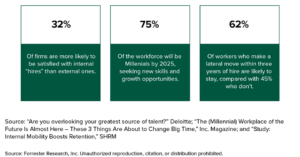Could Internal Talent Marketplaces Help Us Fix Talent Mobility?
One of the top drivers of employee experience is having opportunities to advance at work (this is easy to find in Forrester’s employee experience research). In the age of shorter tenures and flatter organizations, leaders look to talent mobility to increase opportunities for growth and advancement, instead of promotions. And talent mobility has big benefits for an organization, such as increasing retention, quality of hires, and time to productivity and decreasing the cost to hire.

But not all talent mobility is good for the organization. In fact, the way most organizations execute talent mobility may actually do more harm than good. It has to do with the two ways to execute internal talent mobility: formal (job postings and interviews) vs. informal (word of mouth, sponsorship, and networking). Surprisingly, a Harvard Business Review study reviewing over 11,000 internal hires made across five years at a global Fortune 100 firm found a stark difference between the employees sourced formally and informally, “on nearly every conceivable dimension of quality.” They found that the informal path to mobility netted worse outcomes than formal posting, from performance to productivity and retention.
So when it comes to internal hires, formal is the way to go, but how do you operationalize that at scale? And what if you could go beyond open roles to recruit employees into open projects, committees, and learning experiences? What if you could use the same platform to match employees with mentors, coaches, and subject matter experts? That’s what the new internal talent marketplaces offer: mobility and opportunity at scale.
In my report, Future Fit Talent Mobility And The Talent Marketplace, I outline the benefits of talent marketplaces and explore the future that these technologies enable. If you’re using a talent marketplace at your organization, or are curious about the concept, I’d love to talk to you.
